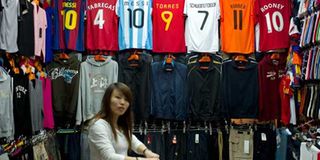Genuine or fake designer wear?

A Chinese shopkeeper arranges clothes next to fake FIFA football jerseys at a stall in a market that sells a lot of counterfeit merchandise in Shanghai on September 3, 2010. The European Union was pressing China on September 3 to back up words with actions and do more to stem the flood of counterfeit goods flowing into Europe and countries around the world. PHOTO | AFP
What you need to know:
- Knock offs and counterfeits are now sold globally and blatantly, online. Gucci sued Alibaba for making counterfeits accessible. The latter were also sued by Puma and Yves Saint Laurent. Alibaba promised to pull counterfeits off their site.
- But how would you know the real deal? Enough vloggers/bloggers will show you. Genuine Christian Louboutins for instance cost an upward of $400 (Sh4,000) depending on the style and year. In Kenya they go for as little as Sh1,500.
- Astonishingly Women’s Wear Daily published “The Benefits of Counterfeit Competition.” Turns out studying 31 brands doing business in China for 10 years revealed too much counterfeiting forces brands to re-evaluate and differentiate.
Do you own something by a famous designer? How sure are you it is original? The first test is assuming cost. The more expensive, the more presumably genuine. Not true. Just to clarify.
Knock offs: a copy or imitation, especially of an expensive product like Channel, Guchi or Lui Futon.
Counterfeit: made in exact imitation of something valuable with the intention to deceive and defraud; also a fraudulent imitation with less luxe or elegant finishing, detailing, fabric, colour or even size. China is legend for this.
Infringement: ripping off of original designs by another designer, also known as copy cat for example Aquazzura versus Ivanka Trump and Steve Madden, both for ripping off it’s Wild Thing tasselled heels, and Madden for further ripping off, and renaming, Sexy Thing and Christy heels — or identical products made by a former factory in the supply chain.
Actual stores got shut down and peddlers picked off the streets.
Knock offs and counterfeits are now sold globally and blatantly, online. Gucci sued Alibaba for making counterfeits accessible. The latter were also sued by Puma and Yves Saint Laurent. Alibaba promised to pull counterfeits off their site, considering a sort of QR code authentication. An out of court settlement could not be reached with Gucci.
UNLIKELY COOPERATION
As of last week, Puma was concerned about fake Rihanna creepers declaring it bad for business. Forever 21 was the culprit selling fake Fenty X Puma. Forever 21 has 723 stores and is valued at $4.4 billion (Sh400 billion).
But how would you know the real deal? Enough vloggers/bloggers will show you. Genuine Christian Louboutins for instance cost an upward of $400 (Sh4,000) depending on the style and year. In Kenya they go for as little as Sh1,500. If the lie is persistent and consistent depending on the shoe store to the ramp and finishing, unboxing will tell. Thorough research cancels out being enamoured by the immediate look and low, low price. Note the counterfeit industry is worth $600 billion (Sh 60trillion) annually. All parties are heavily invested.
Fashion law is such a new arena there are yet to be a class of graduates anywhere in the world. Whatever exists is a collaboration of varied interests, lobbying and hard hitting commerce. There was a suggested American Act. It offers the option of granting designers a three year copyright limitation to own their creation.
By which time the trend has passed courtesy saturating the market, turned boring, grown old and fusty, died or lawd knows, done a 360 and returned hotter than ever. One can however copyright a two-dimensional pattern or sketch but not clothing.
One cannot patent either. Patents thrive under textile innovation and technology like invented fabric, method of distressing fabrics or a machine that does interesting things to fabric. There is a strong aspect of science involved. Patents also take years to review. Trademark count. Like the Nike swoosh. In fact Adidas won a $300m judgment in 2008 against a business that sold shoes with two or four stripes remarkably similar to the original three stripes.
Astonishingly Women’s Wear Daily published “The Benefits of Counterfeit Competition.” Turns out studying 31 brands doing business in China for 10 years revealed too much counterfeiting forces brands to re-evaluate and differentiate. Companies that have survived infringement suits “all significantly improved their shoes’ surface, side materials and appearance. Subsequently both brand image and customer loyalty are enhanced.” Who knew.
Can you detect a fake?
- The most faked goods are handbags because they are also the most accessible luxury product. True luxury products are meant to age gracefully, lasting generations.
External details are easiest to fake. Genuine articles come with authentication. In proper English. And logos. And perfect stitching.
Know your preferred designer label well by schooling yourself. Visit sites that show you how to tell the difference.
If it makes you feel any better, Coco Chanel is believed to have said, “Fashion should slip out of your hands. The very idea of protecting the seasonal arts is childish. One should not bother to protect that which dies the minute it is born.”





